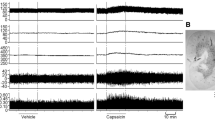Summary
-
1.
I.v. injection of 1 or 3 μg capsaicin led to a triphasic blood pressure response in Sprague-Dawley rats but, in contrast to Wistar rats, did not affect heart rate and respiration. The blood pressure response was a sequence of fall (A), return to normal levels or slight rise (B), and fall (C) in blood pressure The blood pressure response to capsaicin remained unchanged after treatment with adrenoceptor or cholinoceptor antagonists.
-
2.
The initial fall in blood pressure (A) was absent after bilateral vagotomy and in the pithed rat. The delayed fall in blood pressure (C) remained unchanged after vagotomy, but was absent after neonatal capsaicin pretreatment and in the pithed rat. Effect B was not diminished after vagotomy or despinalization; it was augmented in rats treated neonatally with capsaicin.
-
3.
I.a. injection of capsaicin into the hind leg caused a reflex fall in blood pressure which was changed to a reflex rise in rats treated with capsaicin as neonates.
-
4.
The initial and the delayed fall in blood pressure after i.v. injection of capsaicin seems to be reflex responses to stimulation of capsaicin-sensitive small diameter afferent fibres. The intermediate rise in blood pressure appears to result mainly from a direct short vasoconstriction by capsaicin.
Similar content being viewed by others
References
Coleridge HM, Coleridge JCG, Kidd C (1964) Role of the pulmonary arterial baroreceptors in the effects produced by capsaicin in the dog. J Physiol 170:272–285
Crayton SC, Mitchell JH, Payne FC (1981) Reflex cardiovascular response during injection of capsaicin into skeletal muscle. Am J Physiol 240:H315-H319
Ferreira SH, Moncada S, Vane JR (1973) Prostaglandins and the mechanism of analgesia produced by aspirin-like drugs. Br J Pharmacol 49:86–97
Gamse R, Lembeck F, Cuello AC (1979) Substance P in the vagus nerve: immunochemical and immunohistochemical evidence for axoplasmic transport. Naunyn-Schmiedeberg's Arch Pharmacol 306:37–44
Gamse R, Holzer P, Lembeck F (1980) Decrease of substance P in primary afferent neurones and impairment of neurogenic plasma extravasation by capsaicin. Br J Pharmacol 68:207–213
Gamse R, Wax A, Zigmond RE, Leeman SE (1981a) Immunoreactive substance P in sympathetic ganglia: distribution and sensitivity towards capsaicin. Neuroscience 6:437–441
Gamse R, Leeman SE, Holzer P, Lembeck F (1981b) Differential effects of capsaicin on the content of somatostatin, substance P, and neurotensin in the nervous system of the rat. Naunyn-Schmiedeberg's Arch Pharmacol 317:140–148
Gillis RA, Helke CJ, Hamilton BL, Norman WP, Jacobowitz DM (1980) Evidence that substance P is a neurotransmitter of baro- and chemoreceptor afferents in nucleus tractus solitarius. Brain Res 181:476–481
Haeusler G, Osterwalder R (1980) Evidence suggesting a transmitter or neuromodulatory role for substance P at the first synapse of the baroreceptor reflex. Naunyn-Schmiedeberg's Arch Pharmacol 314:111–121
Helke CJ, Goldman W, Jacobowitz DM (1980) Demonstration of substance P in aortic nerve afferent fibers by combined use of fluorescent retrograde neuronal labeling and immunocytochemistry. Peptides 1:359–364
Hökfelt T, Elfvin LG, Schultzberg M, Goldstein M, Nilsson G (1977) On the occurrence of substance P-containing fibers in sympathetic ganglia: immunohistochemical evidence. Brain Res 100:235–252
Jancsó G, Kiraly E, Jancsó-Gábor A (1977) Pharmacologically induced selective degeneration of chemosensitive primary sensory neurons. Nature 270:741–743
Juan H, Lembeck F (1974) Action of peptides and other algesic agents on paravascular pain receptors of the isolated perfused rabbit ear. Naunyn-Schmiedeberg's Arch Pharmacol 283:151–164
Konishi S, Tsunoo A, Yanaihara N, Otsuka M (1980) Peptidergic excitatory and inhibitory synapses in mammalian sympathetic ganglia: roles of substance P and enkephalin. Biomed Res 1:528–536
Lembeck F, Donnerer J (1981) Time course of capsaicin-induced functional impairments in comparison with changes in neuronal substance P content. Naunyn-Schmiedeberg's Arch Pharmacol 316:240–243
Longhurst JC, Mitchell JH, Moore MB (1980) The spinal cord ventral root: an afferent pathway of the hind-limb pressor reflex in cats. J Physiol 301:467–476
Makara GB, György L, Molnar J (1967) Circulatory and respiratory responses to capsaicin, 5-hydroxytryptamine and histamine in rats pretreated with capsaicin. Arch Int Pharmacodyn 170:39–45
Matthews MR, Cuello AC (1982) Substance P-immunoreactive peripheral branches of sensory neurones innervate guinea-pig sympathetic neurones. Proc Natl Acad Sci USA (in press)
Nagy JI, Hunt SP, Iversen LL, Emson PC (1981) Biochemical and anatomical observations on the degeneration of peptide-containing primary afferent neurons after neonatal capsaicin. Neuroscience 6:1923–1934
Pórszász J, Such G, Pórszász-Gibiszer K (1957) Circulatory and respiratory chemoreflexes. I. Analysis of the site of action and receptor types of capsaicine. Acta Physiol Acad Sci Hung 12:189–205
Reinecke M, Weihe E, Forssmann WG (1980) Substance P-immunoreactive nerve fibers in the heart. Neurosci Lett 20:265–269
Scadding JW (1980) The permanent anatomical effects of neonatal capsaicin on somatosensory nerves. J Anat 131:473–484
Shipley RE, Tilden JN (1959) A pithed rat preparation suitable for assaying pressor substances. Proc Soc Exp Biol Med 64:453
Szolcsányi J (1977) A pharmacological approach to elucidation of the role of different nerve fibres and receptor endings in mediation of pain. J Physiol (Paris) 73:251–259
Szolcsányi J, Jancsó-Gábor A, Joó F (1975) Functional and fine structural characteristics of the sensory neuron blocking effect of capsaicin. Naunyn-Schmiedeberg's Arch Pharmacol 287:157–169
Toda N, Usui H, Nishino N, Fujiwara M (1972) Cardiovascular effects of capsaicin in dogs and rabbits. J Pharmacol Exp Ther 181:512–521
Toh CC, Lee TS, Kiang AK (1955) The pharmacological actions of capsaicin and analogues. Br J Pharmacol 10:175–182
Virus RM, Gebhart GF (1979) Pharmacologic actions of capsaicin: apparent involvement of substance P and serotonin. Life Sci 25:1273–1284
Virus RM, Knuepfer MM, McManus DQ, Brody MJ, Gebhart GF (1981) Capsaicin treatment in adult Wistar-Kyoto and spontaneosly hypertensive rats: effects on nociceptive behavior and cardiovascular regulation. Eur J Pharmacol 72:209–217
Author information
Authors and Affiliations
Rights and permissions
About this article
Cite this article
Donnerer, J., Lembeck, F. Analysis of the effects of intravenously injected capsaicin in the rat. Naunyn-Schmiedeberg's Arch. Pharmacol. 320, 54–57 (1982). https://doi.org/10.1007/BF00499072
Received:
Accepted:
Issue Date:
DOI: https://doi.org/10.1007/BF00499072




